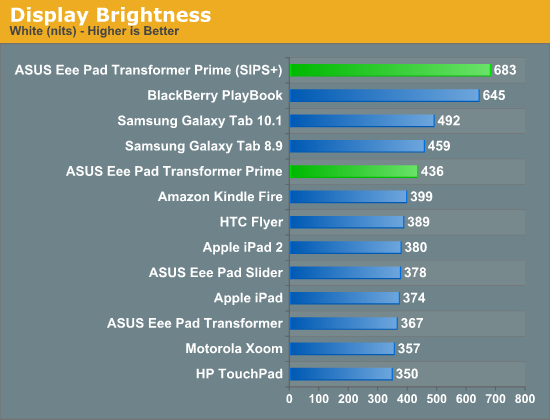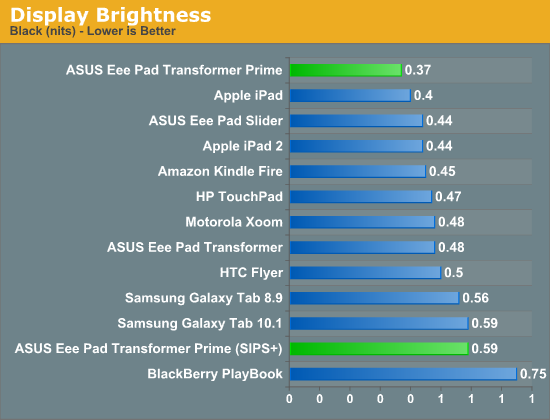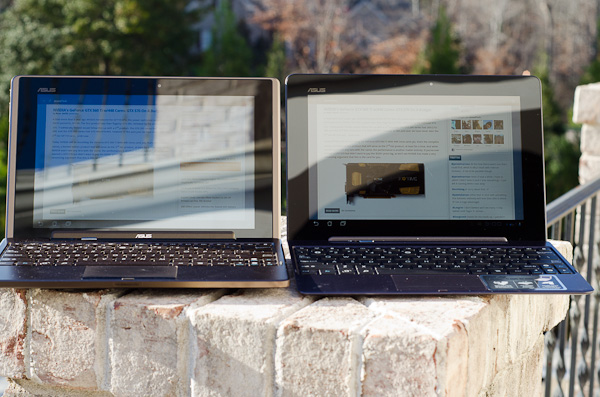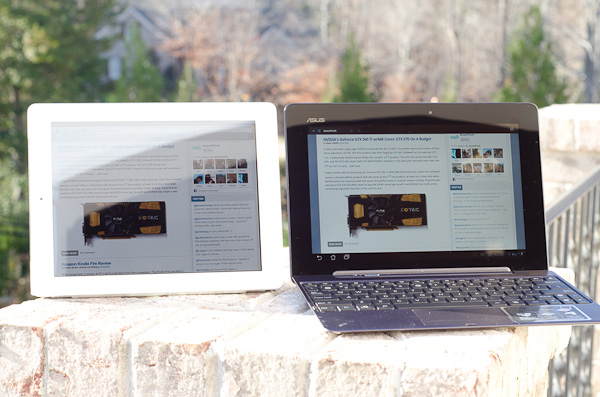ASUS Eee Pad Transformer Prime & NVIDIA Tegra 3 Review
by Anand Lal Shimpi on December 1, 2011 1:00 AM ESTThe Display: Perfect
The original Transformer had a display that performed similarly to the iPad, but was far more reflective thanks to a fairly large gap between the outer glass and the LCD panel underneath. I excused the first generation Eee Pad in the display department because it was good enough and $100 cheaper than the competing Apple solution. The Prime reaches price parity with the iPad 2, and as a result it must meet a higher standard. ASUS doesn't disappoint - the Eee Pad Transformer Prime has the best display I've seen on a tablet to date.
The resolution is a Honeycomb-standard 1280 x 800. The 16:10 panel measures 10.1-inches diagonally, giving it a very similar surface area to the iPad 2's 9.7-inch 4:3 display. The increase in resolution more than makes up for the larger screen however, ASUS delivers 145 pixels per inch compared to the iPad 2's now quite-dated ~132 PPI.
It's not all about pixel density here, the Transformer Prime has better white and black levels than anything else in its class. It also sets the new benchmark for contrast ratio at nearly 1200:1. The huge gap between the outermost glass and the IPS LCD panel has been reduced significantly, in turn reducing glare.



ASUS also has a Super IPS+ mode that drives the display to a class-leading 683 nits. The Super IPS+ mode obviously draws more power but ASUS recommends it if you're trying to use your tablet outdoors. In our review of the PlayBook we found that 600 nits was really the cutoff for usability in sunny conditions, and ASUS easily exceeds that. It's also worth pointing out that while Super IPS+ increases black levels as well, the resulting contrast ratio remains the same.

Original TF (left) vs. Super IPS+ enabled on the TF Prime (right)

iPad 2 (left) vs. Super IPS+ enabled on the TF Prime (right)
Viewing angles are absolutely awesome. Yes this is the same ASUS that let us down with the UX panels but it definitely got the panel right when it came to the Transformer Prime. Fingerprints are still going to be evident on the display but they don't seem to be as bad as on the original Transformer, and they do wipe off easily. This time around ASUS bundles a microfiber cloth to aid in keeping your Transformer looking fresh.
ASUS, Apple and the rest of the tablet world are in hot pursuit of even higher resolution panels, the problem is yields on these small 1080p and 2048x1536 panels just aren't high enough yet. The Android crowd will have to wait, although Apple is apparently pushing very hard (and trying to buy up a lot of inventory) to deliver a "retina display" equipped iPad 2+/3 by Q2 next year. I'm hearing Q3/Q4 for everyone else and it's still not a guarantee that Apple will be able to meet its aggressive targets either at this point.










204 Comments
View All Comments
thunng8 - Thursday, December 1, 2011 - link
It would be pretty hard to beat the visuals of Infinity Blade II on the ipad2. The game looks amazing.TrackSmart - Thursday, December 1, 2011 - link
Anand,Just a heads-up, as I know you had to get this review out the door quickly: It would be really useful to put the weight of the tablet AND keyboard dock prominently on the first page (maybe in the chart?). This would make it easier to compare the total travel weight to ultraportables and netbooks.
I'm guessing that we're talking about 2.6 pounds from what I could find online. And you'd end up with some serious battery life (18 hours?) compared to even the longest running Zacate (or Atom) laptops/netbooks. If only the software and hardware capabilities were as good...
biassj - Thursday, December 1, 2011 - link
Asus looking good but tablets can't replace x86 PCs yet. I hope Asus launches a 15" Zenbook with 1080 display and maybe even a quad core Ivy bridge. I don't mind if it's thicker but I want something to compete with the rumor Macbook Air 15".HighTech4US - Thursday, December 1, 2011 - link
Will the ASUS Eee Pad Transformer Prime be retested here when ICS (Ice Cream Sandwich) is released for it?My understanding is that there are improved graphics drivers and other improvements in the OS that will improve on the results shown here.
vvk - Thursday, December 1, 2011 - link
Hi Anand,It seems that the results of the Ipad 2 and Transformer Prime are quite different in GLBenchmark 2.0.3 Egypt (tested by PCworld) vs. what you have found based on the vs. 2.1 of the same benchmark. Could you comment what may be the reason for the differences?
"The most significant result in our gaming performance tests: The Transformer Prime logged 53 frames per second, the highest frame rate we've seen on the GLBenchmark 2.0.3 Egypt test with no antialiasing. This result topped the Apple iPad 2's previous record of 46 fps, and it just crushed the Android masses we've tested, which averaged 18 fps and topped out at 34 fps (for the 7-inch Acer Iconia Tab A100)."
https://www.pcworld.com/article/245256/asus_eee_pa...
vvk - Thursday, December 1, 2011 - link
Also wanted to add that other sites show much longer battery life for the Transformer. I understand that the battery life depends on use but could be that your unit is a dud in not only in case of WiFi but also battery, so I wonder if you would be willing to repeat the battery test?Anand Lal Shimpi - Thursday, December 1, 2011 - link
I'm already on it :) Got a new Prime in this morning and battery life is looking much better already.Take care,
Anand
metafor - Thursday, December 1, 2011 - link
The tests in the article were done using an off-screen resolution of 1280x720. This allows all devices to be tested at the same resolution -- thus measuring the relative rendering performance of the SoC.Looking at the results on GLBenchmark's own website:
http://www.glbenchmark.com/result.jsp
Correlate to what is posted in the article.
The ones posted by users of Tegra-3 devices:
http://www.glbenchmark.com/phonedetails.jsp?benchm...
Also correlate with the results of the article. I suspect that version 2.0.3 may stress different parts of the GPU or that PC World got some pretty bad results.
vvk - Thursday, December 1, 2011 - link
Well I usually do not play games off-screen :) Anyway, I am still puzzled what is causing the huge difference between the 2.0.3 Egypt vs. 2.1 (assuming both test were done correctly).Also while comparing Ipad 2 at theoretical 720p has merits in synthetic testing in practice you can not see more than 1024 by 768 pixels on the Ipad 2.
I am also wondering if GLBenchmark better than lets say 3dMark for desktop? 3D Mark scores do not always correlate perfectly with real games experience due to optimizations for particular card and also because synthetic testing is not a perfect substitute for real games to start with. So I am not overly concerned about the scores more about what have changed between the GLBenchmark versions.
metafor - Thursday, December 1, 2011 - link
Absolutely. But unfortunately few games for mobile if any offer time-tests and there is no equivalent framerate tool like FRAPs to measure framerate in real games.So synthetic benchmarks will have to do for now.
As for 2.0.3 vs 2.1, GLBenchmark's website doesn't give all too much info except that it includes the off-screen mode as well as "high quality" versions.
But it does mention that 2.1's throughput tests -- which I don't think impact Egypt -- perform warm-up loops in order to cache a lot of its data before measuring GPU throughput.
Other than that, I'm not really sure what changed.